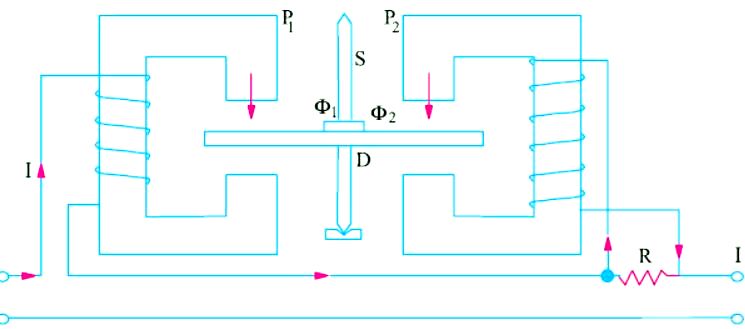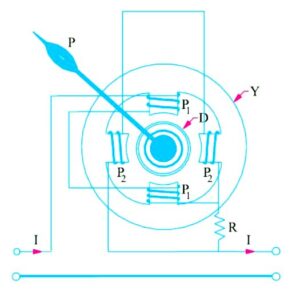Induction Ammeters
It has been shown in Article Induction type Voltmeters and Ammeters above that the net torque acting on the disc of Induction Ammeters is
T = K2 ωΦ1m Φ2m sin α
Obviously, if both fluxes are produced by the same alternating current (of maximum value Im) to be measured, then
T = K3ω(Im)2 sin α
Hence, for a given frequency ω and angle α, the torque is proportional to the square of the current.
If the disc has spring control, it will take up a steady deflected position where controlling torque becomes equal to the deflecting torque. By attaching a suitable pointer to the disc, the apparatus can be used as an ammeter. There are three different possible arrangements by which the operational requirements of induction ammeters can be met as discussed
below.
(i) Disc Instrument with Split-phase Winding
In this arrangement, the windings on the two laminated a.c. magnets P1 and P2 are connected in series (Figure A). But, the winding of P2 is shunted by a resistance R with the result that the current in this winding lags with respect to the total line current. In this way, the necessary phase angle α is produced between two fluxes Φ1 and Φ2 produced by P1 and P2 respectively. This angle is of the order of 60°. If the hysteresis effects etc. are neglected, then each flux would be proportional to the current to be measured i.e. line current I.
Td ∝ Φ1m Φ2m sin α
or Td ∝ I2 where I is the r.m.s. value.
If spring control is used, then Tc ∝ θ

In the final deflected position, Tc = Td
∴ θ ∝ I2
Eddy current damping is employed in this instrument. When the disc rotates, it cuts the flux in the air-gap of the magnet and has eddy currents induced in it which provide efficient damping.
(ii) Cylindrical type with Split-phase Winding
The operating principle of this instrument is the same as that of the above instrument except that instead of a rotating disc, it employs a hollow aluminium drum as shown in Figure B. The poles P1 produce the alternating flux Φ1 which produces eddy current i1 in those portions of the drum that lie under poles P2. Similarly, flux F2 due to poles P2 produces eddy current i2 in those parts of the drum that lie under poles P1. The force F1 which is ∝ Φ1 i2 and F2 which is ∝ Φ2 i1 are tangential to the surface of the drum and the resulting torque tends to rotate the drum about its own axis. Again, the winding of P2 is shunted by resistance R which helps to introduce the necessary phase difference α between F1 and F2.
The spiral control springs (not shown shown in the figure) prevent any continuous rotation of the drum and ultimately bring it to rest at a position where the deflecting torque becomes equal to the controlling torque of the springs. The drum has a pointer attached to it and is itself carried by a spindle whose two ends fit in jewelled bearings. There is a cylindrical laminated core inside the hollow drum whole function is to strengthen the flux cutting the drurm. The poles are laminated and magnetic circuits are completed by the yoke Y and the core.
Damping is by eddy currents induced in a separate aluminium disc (not shown in the figure) carried by the spindle when it moves in the air-gap flux of a horse-shoe magnet.
AdBlock-2

(iii) Shaded-pole Induction Ammeter
In the shaded-pole disc type induction ammeter (Figure C) only single flux-producing winding is used. The flux F produced by this winding is split up into two fluxes Φ1 and Φ2 which are made to have the necessary phase difference of α by the device shown in Figure C. The portions of the upper and lower poles near the disc D are divided by a slot into two halves one of which carries a closed ‘shading’ winding or ring. This shading winding or ring acts as a short-circuited secondary and the main winding as a primary. The current induced in the ring by transformer action retards the phase of flux Φ2 with respect to that of Φ1 by about 50° or so. The two fluxes Φ1 and Φ2 passing through the unshaded and shaded parts respectively, react with eddy currents i2 and i1 respectively and so produce the net driving torque whose value is
Td ∝ Φ1m Φ2m sin α
Assuming that both Φ1 and Φ2 are proportional to the current I, we have
Td ∝ I2

This torque is balanced by the controlling torque provided by the spiral springs. The actual shaded-pole type induction instruments is shown in Figure D. It consists of a suitably- shaped aluminium or copper disc mounted on a spindly which is supported by jeweled bearings. The spindle carries a pointer and has a control spring attached to it. The edge or periphery of the disc moves in the air-gap of a laminated a.c. electromagnet which is energized either by the current to be measured (as ammeter) or by a current proportional to the voltage to be measured (as a voltmeter). Damping is by eddy currents induced by a permanent magnet embracing another portion of the same disc. As seen, the disc serves both for damping as well as operating purposes. The main flux is split into two components fluxes by shading one-half of each pole. These two fluxes have a phase difference of 40° to 50° between them and they induce two eddy currents in the disc. Each eddy current has a component in phase with the other flux, so that two torques are produced which are oppositely directed. The resultant torque is equal to the difference between the two. This torque deflects the disc-continuous rotation being prevented by the control spring and the deflection produced is proportional to the square of the current or voltage being measured.

As seen, for a given frequency,
Td ∝ I2 = KI2
For spring control
Tc ∝ θ or Tc = K1 θ
For steady deflection, we have Tc = Td or θ ∝ I2
Hence, such instruments have uneven scales i.e. scales which are cramped at their lower ends. A more even scale can, however, be obtained by using a cam-shaped disc as shown in Figure D.
Read article – Induction type Voltmeters and Ammeters
Visit NCERTplanet.com for NCERT solutions and Textbook downloads




